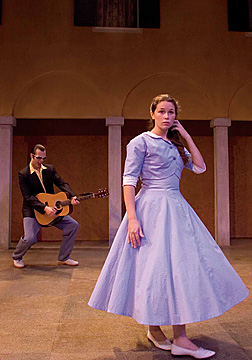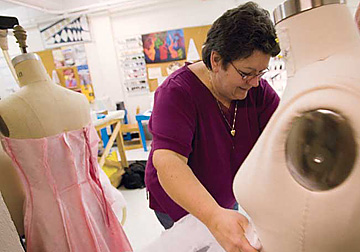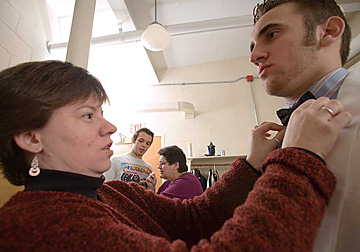Dressing the Part

Molly Joyce Marquand ’06 (Bianca) and Dane Cunningham ’07 (Hortensio, making like Elvis) perform a scene from Taming of the Shrew.
What if Katherina is a shrew simply because the gossipmongers of Padua say so? What if her reputation reflects their quaint social conventions more than it does her behavior? Thus did Professor of Theater Paul Kuritz begin an e-mail brainstorming session about the department’s fall production, William Shakespeare’s The Taming of the Shrew.
And what if Kate lives in a time and place where her behavior signals rebellion, not ill temper? What if she has done nothing wrong except defy the tongue-waggers’ image of the ideal girl? So countered Assistant Professor of Theater B. Christine McDowell.
Back and forth the ideas flew. By the time fall semester rolled around, Kuritz, the director, and McDowell, the costume and set designer, shared a vision for Shakespeare’s lighthearted look at courtship and marriage: spirited Katherina and her mild-tempered sister, Bianca, would find love and marriage in 1950s Italy, where the pop melodies of Perry Como and Dean Martin waft from the windows of the ancient architecture.
Instead of dressing a shrill Katherina in the usual 16th-century cleavage-baring gown, McDowell would put pale green Capri pants, snug black sweater, and heels on a bohemian Katherina (Kym Bell ’07, heavily eye-lined). Shy Bianca (ponytailed Molly Joyce Marquand ’06) would wear sweet Peter Pan collars and crinoline dresses with flats. Think Sophia Loren versus Sandra Dee.
Kuritz and McDowell’s unconventional approach to a play written in 1592 demonstrates the degree to which unsung but very important props — costumes — express a production’s themes. In turn, costume shop manager Kathleen Peters and her crew of student seamsters and seamstresses play the crucial role of bringing McDowell’s designs to life. It’s a fine example of the typical teamwork behind a Bates production.
“I talked to Chris about what I thought the play was about, and I respect her ability to come up with a visual way to represent that,” says Kuritz, whose team also includes technical director Michael Reidy.
“She’s the expert in the visual stuff. She could have picked anything and I would have gone along with it. It’s the first time we’ve worked together, so I assume she’s perfect. She hasn’t done anything to disabuse me of that notion.”

At above right, (top photo) Assistant Professor of Theater Christine McDowell fits Stephen Lattanzi ’08 (Petruchio) for his formal wear in the Pettigrew Hall costume shop asCostume shop manager Kathleen Peters works with Dane Cunningham ’07, who plays Hortensio.
New to Bates this academic year, McDowell has worked as a freelance theater designer in New York and taught theatrical design at SUNY–New Paltz, The College of William and Mary, and the University of South Florida. This was her second Taming of the Shrew (her first was set in early 20th-century Miami).
“When you sit with a director the first time, the question is, how much rope do we get? The playwright is the post; how long is the tether?” McDowell explains. “Tennessee Williams told you exactly what color Blanche’s nightgown is in A Streetcar Named Desire. He was very specific and insisted you be true to his vision. By contrast, it’s common to see Shakespeare taken out of the 16th century. Every production is an opportunity to come at it fresh. We happened to choose a play that made our playground really big.”
Still, conservative 1950s Italy was hardly a whimsical choice. Padua was Shakespeare’s chosen setting, after all, but McDowell and Kuritz believed the motif of shifting cultural mores would come across better in an updated setting. “It had to be a time when everyone agreed what marriage was and what the roles of men and women were,” Kuritz says. “The last time the world was that way probably was in the late ’50s and ’60s. It also was a time when people still had something to rebel against.”
While McDowell’s set was stunning — the audience sat in the middle of an Italian piazza built on three walls of the black box Gannett Theater — her vintage costumes carried the job of visually communicating the themes. Several of the 17 cast members played “costume karma” with Peters’ trove of costumes from past productions. “Kathy and I put them in a lot of things and allowed them to choose what made them feel confident and looked right for the part too,” McDowell said. “If you put students in something that makes them feel dumb, they will never make it work.”

Assistant Professor of Theater Christine McDowell fits Stephen Lattanzi ’08 (Petruchio) for his formal wear in the Pettigrew Hall costume shop.
It’s fun to watch them become who they think they should be on stage,” says Peters, who has managed the shop, the department’s social center, since 1996. She and several work-study students made from scratch the balance of the costumes, including twin wedding dresses for Katherina — one for the ceremony, the other for an after-the-wedding scooter ride through the mud. The dress was splattered with washy brown paint (real mud dries and flakes), a gentle treatment compared with others Peters has employed. “I’m the ultimate dirtier,” she says. “I’ve even driven my car over costumes.”
Student costumers typically come to Peters with little, if any, sewing experience. “Once a student works in the costume shop, they will stay for all four years that they are at Bates,” Peters says proudly. “They leave with a set of skills they never dreamed they’d acquire at college. I’ve had students go on to be costume shop managers.”
The Bates students who work for pay (the going rate these days is between $6.50 and $7 per hour, campus-wide) are more dedicated than students who build costumes to fulfill class requirements at other schools, McDowell has discovered. “It’s their job, and Kathy is good about making it project-based so they get a tremendous sense of accomplishment. They are making something very specific and they get to see it on stage.”
Kuritz, McDowell, and company are now entertaining a production where every costume will be built from the underwear up. “We were joking about doing Death of a Salesman in 18th-century dress,” McDowell says. “That would be quite an experiment.”
Freelance writer Virginia Wright lives in Cumberland, Maine. Her most recent story for Bates Magazine was “After the Fire” in the Spring 2005 issue.